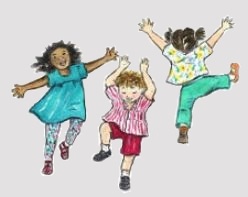"Babies don't learn by memorizing lists.
Why should children or adults?"

The definition of TPR
Total Physical Response (TPR) is a method of teaching a foreign language which is based on the coordination of speech and action. The method was developed by a professor of psychology at San José State University, Dr. James J. Asher.
The basics of TPR lie in the belief that the process of acquiring any foreign language should follow the pattern of native language acquisition, in which a learner spend much time learning to decode the messages heard and seen before actually reproducing the language itself.
The Importance of TPR
The TPR method of teaching a language can be used for a variety of purposes: teaching vocabulary, and classroom language, imperative sentences or some other aspects of grammar. Moreover, this method is a good alternative for teaching students with learning disabilities who have problems learning with traditional approaches.
The Shortcomings of the TRP Method Include:
- The TRP is best suitable for beginners.
- Students don’t get a chance to express their thoughts.
- This will come later in the program.
- The method can be challenging for shy students.
- They will open up after a few classes.
- The method emphasizes imperative constructions, which may lead to the future inappropriate and rude language of the learner.
To make this basic TPR more interesting, teacher Joe uses some rather funny commands. For example, after telling students to put their left hand in the air, he has them put both hands in the air, then follows up by asking students to put both FEET in the air.
The whole sequence is below:
Any questions? - put your left hand in the air - put it down - put your right hand in the air - put it down - put both hands in the air - put them down - put your left foot in the air - put it down - put your right foot in the air - put it down - put both feet in the air!
Students try jumping in the air or attempt a handstand on their desks!
Another funny sequence of basic TPR is this:
Clap your hands - clap your hands three times - clap them five times - clap your hands 800 times! - turn around - turn around twice then clap once - jump once - jump seven times - turn around, jump once and clap twice - turn three times, jump five times and clap twice!
Students really struggle hard to remember this last one, but if you do it step by step and repeat often, they can do it eventually.
The Advantages of the TPR Method are:
- Students enjoy moving around the classroom during the lesson.
- Teachers are not required to prepare long hours beforehand.
- The method is suitable for classrooms of children with mixed abilities or disabilities.
- The method is effective for both adults and young children.
- The classroom size does not pay big role.
- Second language learns in the same ways as the first language is learned.
- Students should develop listening skills first, and speaking skills afterwards.
- The child’s response to spoken language is usually physical, so adult learners should do that as well when learning a foreign language.
- After the listening comprehension skills are developed, speech develops without much effort from the speaker.
- In the process of learning, adults use right-brain motor activities, while the left hemisphere is left to watch and learn.
- Postponing the speech learning reduces stress. The theoretical foundation of this approach relies on certain principles.
The Resurgence of Total Physical Response
Though it was developed in the 1970s by James Asher, TPR is still a very popular method and seems to have been recently rediscovered in the modern language classroom. In this method, the teacher presents a new vocabulary word with an action that students repeat: for example, to teach the verb cry, teacher would pretend to cry while saying the word, which students would then mirror. TPR is often used with teaching children, and the teacher often builds up a story using a series of vocabulary words.
TPR's Influence in the Communicative Approach
An extremely useful part of TPR used in modern language teaching through Communicative Language Teaching is acting out vocabulary words so that students understand their meaning without automatically translating the word in their native language. Successful language teaching helps students step outside of their first language so that they can more effectively communicate in their new language.
Translating from the student's native language is not only slower, but is also inaccurate because often a direct translation doesn't exist, the language structure is different, and phrases and sayings often very different. If students can learn cry by thinking of the action rather than translating from their own language, they are more likely to remember the word and will be faster and more effective in their new language.
References:
http://www.foreignlanguagesweb.com/teaching/methods/tpr.htm
http://www.wikipedia.org/
Dr. James J. Asher’s own website.
In lesson structure, "PPP" means Presentation, Practice, and Production. One of the most common errors untrained teachers make is that they talk too much. Learn about it here.
Everyone knows, learning a second language is difficult. There are three main types of styles in which individuals are often categorized under when it comes to learning. Are you one of these learning types? Click here to find out what learning type you are.
